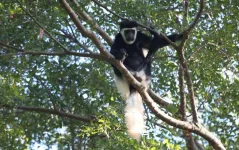(Press-News.org) A system of wearable sensors and machine learning can continuously monitor factory workers for signs of physical fatigue. Factory work can be physically strenuous, and a safe and ethical workplace must ensure that workers do not become overly fatigued, which can increase the risk of injury and accident, cause chronic health problems, and also impair performance. A system designed by Ping Guo, Qi Zhu, and colleagues measures heart rate, heart rate variability, skin temperature, and locomotor patterns from six locations on the torso and arms. There are no broadly accepted biomarkers or metrics for fatigue, so the authors calibrated their measurements to self-reported perceived exertion, on a 0–10 scale. Forty-three participants, ages 18–56 years old, replicated two strenuous manufacturing tasks: composite sheet layup and wire harnessing, while wearing weighted vests to exaggerate the induced fatigue and simulate levels of fatigue that might be felt at the end of a full shift. Participants reported fatigue levels at multiple time points throughout a roughly hour-long data collection period. A machine learning model was able to use data from participants to predict fatigue levels in real time. The best mix of physiological signs to use to predict fatigue varied across individuals, but some universal trends were identified. The movements of the non-dominant arm universally betrayed fatigue. Whereas complex tasks such as wire harnessing required multiple modalities to capture fatigue. The authors also tested their system at large manufacturing factories in the US Midwest and West Coast. Real factory workers were somewhat reluctant to report that their work tasks were fatiguing and sweat made the adhesion of the sensors tricky. Despite these challenges, workers rated the system as unobtrusive and easy to use. According to the authors, the technology could improve factory safety, mitigate risks, and empower workers.
END
Continuous monitoring of fatigue in factory workers
2024-10-15
ELSE PRESS RELEASES FROM THIS DATE:
Farmer ants’ wearable bacteria
2024-10-15
A study investigates the evolution of beneficial bacteria that live inside and on the surface of farming ants. Attine ants farm fungi, in one of the natural world’s best-studied mutualistic symbioses. In the 1990s, the picture of this mutualism was expanded to include another partner: an actinobacteria, Pseudonocardia, which lives on the ants’ cuticle—their hard exoskeleton—where its cultures are fed by secretions of subcuticular glands. Pseudonocardia is known to kill the fungal pathogen Escovopsis, that might destroy the ants’ mutualistic fungus. Jacobus J. Boomsma and colleagues sequenced samples ...
Political polarization and trust
2024-10-15
A collection of 15 articles from the Polarization and Trust Special Feature explores the complex nature of the emotional divide between political opponents, using approaches from a variety of disciplines, including political science, psychology, sociology, and economics. The articles emerged from a 2023 workshop on “Directions of Polarization, Social Norms, and Trust in Societies,” held at MIT and organized by Kati Kish Bar-On, Eugen Dimant, Yphtach Lelkes and David Rand. Researchers from a number of teams identified ways in which partisans mistrust and inaccurately perceive their political opponents, and other teams examined why such inaccurate ...
Study uncovers how silkworm moth's odor detection may improve robotics
2024-10-15
The silkworm moth (Bombyx mori) is an insect that no longer flies due to domestication. The males use their antennae to detect pheromones emitted by females and respond very acutely, and have been used as model insects for the study of their odor source localization. Flying insects flap their wings when they fly, and silkworm moths are also known to flap their wings (called fanning) when they detect pheromones, even though they do not fly. As pheromone molecules move through space in the air, the air flows ...
New study links obesity to elevated hypertension risk among young middle eastern women
2024-10-15
Obesity is a widespread public health challenge in the Middle East, maintaining prevalence in 54.2% of women and 31.4% of men in this region. Overweight and obese women have a higher risk of hypertension and cardiovascular risk factors than women with a standard BMI, according to an analysis of the ANCORS-YW STUDY presented at ACC Middle East 2024. The findings highlight the urgent need for targeted interventions that address socioeconomic determinants of health to reduce the cardiovascular risk ...
How ‘vaccinating’ plants could reduce pesticide use and secure global food supplies
2024-10-15
In a growing and changing world, we need to find ways of putting food on everyone’s table. Pesticides have enabled mass cultivation on an incredible scale, but they can have harmful secondary effects on humans and wildlife, and pests are rapidly evolving to overcome them. To overcome this challenge and develop the sustainable and resilient agriculture of the future, scientists writing in Frontiers in Science explore the potential of induced resistance. Like a vaccination for plants, it deliberately triggers a plant’s immune system, so that when the plant encounters a similar ...
Seven new frog species discovered in Madagascar: sounds like something from Star Trek
2024-10-15
Seven New Frog Species Discovered in Madagascar: Sounds Like Something from Star Trek
An international team of researchers have discovered seven new species of tree frogs that make otherworldly calls in the rainforests of Madagascar. Their strange, high-pitched whistling calls sound more like sound effects from the sci-fi series Star Trek. As a result, the researchers have named the new species after seven of the series' most iconic
If you think all frogs croak, you’d be wrong. Seven newly discovered species from the tree frog genus Boophis, found across the rainforests of Madagascar, emit special bird-like whistling ...
New temperatures in two thirds of key tropical forest
2024-10-15
Two thirds of Key Biodiversity Areas (KBAs) in tropical forests are experiencing new temperature conditions as our climate changes, research shows.
KBAs identify the most important places on Earth for species and their habitats.
The new study – by Exeter, Manchester Metropolitan and Cambridge universities – assessed 30 years of temperature conditions below the forest canopy in KBAs in tropical forests worldwide.
It found that 66% of KBAs in tropical forests have recently transitioned to new “temperature regimes” (more than 40% of temperature measurements being outside the range previously recorded ...
Fearful memories of others seen in mouse brain
2024-10-15
NEW YORK, NY — How do we distinguish threat from safety? It’s a question important not just in our daily lives, but for human disorders linked with fear of others, such as social anxiety or post-traumatic stress disorder (PTSD). The microscope image accompanying this press release, from the laboratory of Steven A. Siegelbaum, PhD, at Columbia’s Zuckerman Institute, displays a powerful technique scientists used to help us find an answer.
The scientists were investigating the hippocampus, a brain area that plays a key role in memory in humans and mice. Specifically, they focused on the CA2 region, which is ...
Rangers lead ground-breaking effort to monitor Uganda's lion population in critical stronghold
2024-10-15
In a new study published in Nature Communications Biology, wildlife rangers from the Uganda Wildlife Authority have demonstrated their ability to generate precise and reliable data on lion populations in Uganda’s Nile Delta, a critical stronghold for African lions.
The study reveals that wildlife rangers, a critical component of global conservation efforts but often underutilised in scientific research, can play a pivotal role in the conservation science surrounding the world’s most beloved big cat.
Rangers are effective at monitoring lions and are an underutilised resource
The study showed rangers ...
Modern mass extinction in an Ecuadorean cloud forest found to be a mirage
2024-10-15
One of the most notorious mass extinction events in modern times occurred on a hilltop in coastal Ecuador in the 1980s. Ninety species of plants known from nowhere else on Earth—many of them new to science and not yet given a name—went extinct when the last cloud forests of the Centinela range were cleared for agriculture. The cautionary tale of Centinela has long been a driving force in the fight to save the world’s rainforests. But did it really happen?
In a new study published in Nature Plants, an international team of botanists reveals that, indeed, it did not happen. The researchers – who spent years of scouring natural history museums, biodiversity databases, ...










